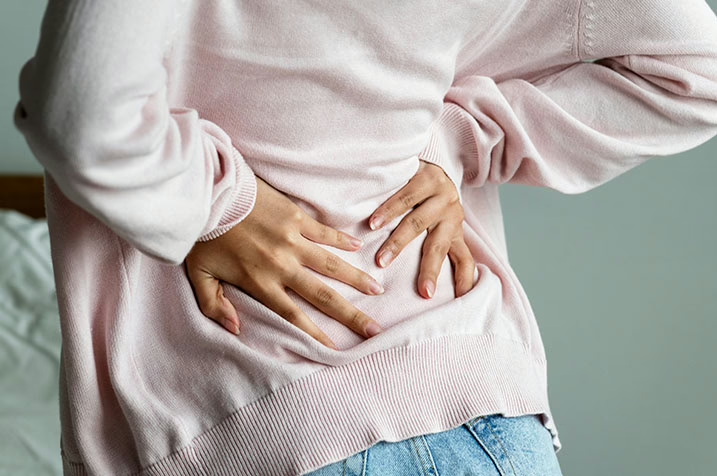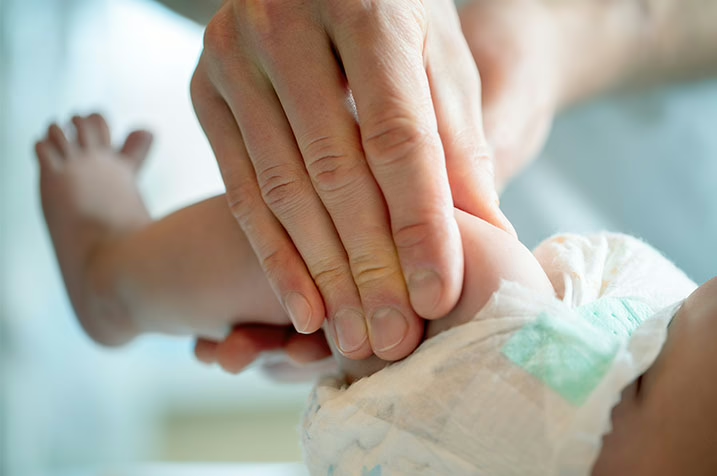Western Pain Diagnosis Through an Eastern Lens

Western Pain Diagnosis Through an Eastern Lens Link copied! The following content was presented by Physician Leong at the Helping CHEN Summit by Pfizer on 11 May 2019. Many people have experienced pain relief with TCM treatments, but often don’t understand why they felt their pain go away. In this article written for allopathic doctors (or any curious audience, really), we will cover: What are the ‘western medical names’ for pain conditions identified in TCM? Acupoints that are useful for pain relief If one does not have access to a certified acupuncturist, you can also do acupressure massage on these points for relief. Ethiology (TCM) Common Corresponding Issues/Symptoms Acute Stagnation of Qi and Blood in the lumbar region Traumatic Injury, Soft tissue Sprains and strains Bone Spurs Pain usually fixed and aggravated upon movement and/or pressure Chronic Invasion and retention of pathogenic cold/wind/damp in the meridians (Urinary Bladder (UB), Gall Bladder (GB) and Governing Vessel (GV) Channels) Bone Spurs Slipped Disc/Nerve Irritation Sciatica Pain Pain began after exposure to pathogenic cold/wind/damp (symptoms could be weather related) Heavy sensation and pain in the lumbar region Stiffness of the muscles with possible limitation of movement Chronic Deficiency of the Kidneys Osteoporosis Pain is not severe – experience a sensation of soreness Weakness in the lumbar area as well as in the knees Ageing symptoms – fatigue, frequent urination, blurry vision, cold hands and feet Principles of acupoint selection: Etiology of Pain Acute vs Chronic Pain Patient’s condition: Ability to lie down? Tolerance of pain? Localised Treatment Huantiao (GB 30) Yaoyan (Extra 9) Shenshu (UB 23) Dachangshu (UB 25) Yaoyangguan (GV 3) Mingmen (GV 4) Distant Treatment Etiology & Pathology (TCM) Corresponding Issues/Symptoms A Stagnation of Qi and Blood in the lumbar region Traumatic Injury, Sprains, Contusion Bone Spurs Pain usually fixed and aggravated upon movement and/or pressure B Invasion and retention of pathogenic cold/wind/damp in the corresponding channels and collaterals Bone Spurs Slipped Disc/Nerve Irritation Sciatica Pain Pain began after exposure to pathogenic cold/wind/damp (weather related) Heavy sensation and pain in the lumbar region Stiffness of the muscles with possible limitation of movement C Deficiency of the Kidneys Osteoporosis Pain is not severe – experience a sensation of soreness Weakness in the lumbar area as well as in the knees Ageing symptoms – fatigue, frequent urination, blurry vision, cold hands and feet Etiology & Pathology (TCM) Distant Acupoints to Resolve Root Causes A Stagnation of Qi and Blood in the lumbar region S1-S2 pain, difficulty in rotation – Houxi (SI 3), Wanshunyi (T 22.08), Wanshuner (T 22.09) Pain above L2, bone spurs – Yaotongxue, Zhongbai (T 22.06), Xiabai (T 22.07) B Invasion and retention of pathogenic cold/wind/damp in the corresponding channels and collaterals L4-L5 pain/Sciatica – Weizhong (UB 40) Xuanzhong (GB39), Dabai (T 22.04), Linggu (T 22.05) Bleeding for UB 40. Sciatica with bone spurs – GB 30, Yanglingquan (GB 34), Quchi (LI 11) Expels cold – Yaoyangguan (GV 3), Huofuhai (T 33.07), Jianzhong (T 44.06) Dispel wind – Fengshi (GB 31), Shouwujin (T 33.08), Shouqianjin (T 33.09) Dispel dampness and bone spur – Minghuang (T 88.12), Tianhuang (T 88.13), Qihuang (T 88.14) C Deficiency of the Kidneys Nourish kidneys – Taixi (KD 3), Guanyuan (CV 4), Qihai (CV 6) Improving weakness in the knees – Shenmen (HT 7), Shaohai (HT 3), Yanglingquan (GB 34), Weizhong (UB 40) Do you have issues that may require a physician? Contact us at +65 8087 0486 or drop us a Whatsapp to make an appointment. Disclaimer: The content on this page is for information and educational purposes only. Such medical information may relate to disease, injury, drugs and other treatments, medical devices and/or health products. Medical information does not amount to advice, and if advice is needed an appropriate professional help should be sought. The disclaimer asserts that no warranties or representations are given in respect of the medical information, and that the website operator should not be held liable if a user suffers any injury or loss after relying upon the medical information. RELATED TOPICS YOU MIGHT ALSO LIKE
Understanding Paediatric Massage

Understanding Paediatric Massage Hannie Hong Have you heard of Traditional Chinese Medicine (TCM) Paediatric Massage?Paediatric Massage was developed 2300 years ago and has survived the test of time, helping many adorable children get better. As we know, children do not fancy bitter TCM concoction nor painful injections, Paediatric Massage is a gentle way to help children regain their health. With the increasing recognition of preventive health by parents, like yourself, this relaxing and therapeutic approach has gained popularity and is widely accepted by children of all ages. Let’s explore what it is and how it works! We will also be sharing with you simple techniques that you can perform on your child. What is TCM Paediatric Massage? Since ancient times, this traditional treatment method has played an important role in both disease prevention and treatment of ailments. TCM Paediatric Massage relies on principles of TCM, and techniques performed are in strict compliance with clinical diagnosis. As a child has delicate and soft skin, different massage techniques are used compared to adult Tuina Massages. Children also have unique acupoints that consist of areas and linear points. We will be sharing some straightforward techniques that can be easily picked up by you to help with your child’s general wellness as well. Why is TCM Paediatric Massage more popular now? Not only does it bring about great benefits, it is also a safe and efficient treatment. Paediatric Massage is not painful or harsh like Tuina massages usually done on adults – the techniques used are different due to differences in the physiology of children and adults. More importantly, physical touch plays a vital role in healing1 and this gentle form of treatment will be able to keep children free from medical-related stress they would otherwise experience in hospitals or with taking medications. Now let us explain your children’s physiology and the basis of how this massage works in treating your child’s issues. Understanding Children Physiology from TCM perspective The physiology of a child is different from that of an adult in the following aspects: Firstly, their internal Zang-Fu organs are delicate, especially their Lung, Spleen and Kidney, and their physiological functions have yet to fully mature. Therefore it is easier for external pathogens to enter their body and easier for their digestive system to be affected by the food they take in. Secondly, due to the incomplete development of Yin and Yang in their body, there is a higher tendency to see Yin and Yang imbalances in children. Their body’s self-defenses and self-regulation mechanisms are therefore weaker. Disease progression is also fast in children, and may easily progress into more complicated forms within a short period of time. As such, a quick response is vital. While the balance between Yin and Yang in children is delicate and easily upset, it has a tendency to tilt towards Yang. Children have vibrant and rapid growth and physicians in ancient times have pointed out that the body constitution of a child is full of Yang energy, like a rising sun in the morning. Hence, it is common to see “excess Yang, insufficient Yin” body constitution in a child. The advantage of the children’s body is that due to the highly pure and clean state of the body, children are able to heal at a much faster rate, as long as immediate action is taken to combat the problem. What are the benefits of TCM Paediatric Massage? Understanding the children’s physiology, we know that children are more prone to falling sick, and once sick, the disease progresses and worsens rapidly. If the child has strong immunity, the recovery is similarly quick. Essentially, this means fast response is vital and also reflects the importance of preventive measures to strengthen the child’s immunity. TCM Paediatric Massage elicits fast response by directly stimulating related organ systems to correct the issue at hand and is also a safe long term preventive measure for your kids. TCM Paediatric Massage can be used to treat a wide range of diseases in children. In particular, the effects of Pediatric Massage for common pediatric diseases of the respiratory system and digestive system are pronounced, making this a go-to treatment for such problems2. When a child has a disease, it is usually due to disturbance in normal Qi of certain internal Zang-Fu or due to imbalances in Yin and Yang. By massaging a certain part of the child’s body, the corresponding Zang-Fu in the body will be regulated through meridians to help restore the normal flow, thereby achieving healing. Similarly, through correct massage actions, Yin and Yang imbalances can be corrected. With proper diagnosis, this massage treatment is able to target the root of the issues and capable of treating chronic conditions. In addition to the treatment of diseases, Paediatric Massage can also be used to strengthen the health and immunity of the child, improving their body constitution and increasing the child’s resistance against diseases. Modern research has shown that Paediatric Massage has a positive effect on not only the physiological functions of the body but also the psychological functions as well, with a very strong effect on reducing anxiety in children3. Learning simple paediatric massage techniques As mentioned, there are 3 internal organs in the children where Qi deficiency is more prominent, with Spleen being one of the aforementioned organs. The Spleen is responsible for the intake, processing and distribution of nutrients from food, in the form of Essence, that is essential to our body’s function. Deficiency of Spleen-qi in children can result in weaker digestion, causing symptoms such as diarrhoea, poor appetite, indigestion and bloated stomach. Knowing how important the Spleen is in helping children absorb sufficient nutrients to strengthen their body and grow well, let’s see how you can help your child strengthen their Spleen with simple techniques, specifically in combating the issue of indigestion. The following techniques should be done on the left hand/leg. It can be done 2-3 times a day when your child is suffering from indigestion. 1) 补脾经 Nourishing the Spleen Meridian Location: On the side of thumb away from the other fingers Action: Brush downwards from the tip of the thumb towards the root of the thumb Frequency: 120 – 280 times 2) 清胃经 or 清大肠经 Clearing the Stomach Meridian Location: Base of the palm, below